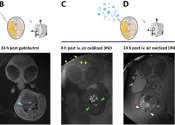Device extracts rare tumor cells using sound
A simple blood test may one day replace invasive biopsies thanks to a new device that uses sound waves to separate blood-borne cancer cells from white blood cells.

A simple blood test may one day replace invasive biopsies thanks to a new device that uses sound waves to separate blood-borne cancer cells from white blood cells.
Engineering
Apr 6, 2015
0
2078

Adherent cells, the kind that form the architecture of all multi-cellular organisms, are mechanically engineered with precise forces that allow them to move around and stick to things. Proteins called integrin receptors act ...
Bio & Medicine
Oct 24, 2014
0
0

Nature has developed a wide variety of methods for guiding particular cells, enzymes, and molecules to specific structures inside the body: White blood cells can find their way to the site of an infection, while scar-forming ...
General Physics
Oct 23, 2014
0
0

A 7-year-project to develop a barcoding and tracking system for tissue stem cells has revealed previously unrecognized features of normal blood production: New data from Harvard Stem Cell Institute scientists at Boston Children's ...
Biotechnology
Oct 5, 2014
1
0

Tibetans were able to adapt to high altitudes thanks to a gene picked up when their ancestors mated with a species of human they helped push to extinction, according to a new report by University of California, Berkeley, ...
Biotechnology
Jul 2, 2014
38
0

Consider the marvel of the embryo. It begins as a glob of identical cells that change shape and function as they multiply to become the cells of our lungs, muscles, nerves and all the other specialized tissues of the body.
Biotechnology
Apr 14, 2014
0
0

An unexpected discovery surprised a scientist at the Max Planck Institute for Intelligent Systems in Stuttgart: Nanometer-sized diamond particles, which were intended for a completely different purpose, shone brightly in ...
Bio & Medicine
2 hours ago
0
1

An intricate simulation performed by UT Southwestern Medical Center researchers using one of the world's most powerful supercomputers sheds new light on how proteins called SNAREs cause biological membranes to fuse.
Molecular & Computational biology
Apr 23, 2024
0
42

EPFL researchers have developed GEMLI, a pioneering tool that could democratize and vastly improve how we study the journey of cells from their embryonic state through to specialized roles in the body, as well as their changes ...
Cell & Microbiology
Apr 11, 2024
0
2

A recent breakthrough sheds light on how the malaria parasite, Plasmodium falciparum, invades human red blood cells. The study, led by the Swiss Tropical and Public Health Institute (Swiss TPH) and Griffith University's Institute ...
Cell & Microbiology
Apr 3, 2024
0
0